

Gnosis ~ Biblioteca Gnostica Samael Aun Weor. Speculum Humanae Salvationis. Jacob's Ladder from a Speculum of c. 1430, pre-figuring the Ascension, right The Ascension from the same manuscript, see left.
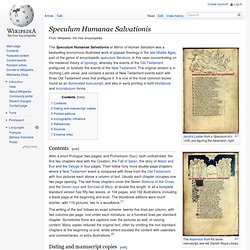
Danish Royal Library Contents[edit] The writing of the text follows an exact scheme: twenty-five lines per column, with two columns per page, one under each miniature, so a hundred lines per standard chapter. Sometimes there are captions over the pictures as well, of varying content. Dating and manuscript copies[edit] Miniature from a manuscript Speculum. The work originated between 1309, as a reference to the Pope being at Avignon indicates, and 1324, the date on two copies.[3] A preface, probably from the original manuscript, says the author does not give his name out of humility, though numerous suggestions have been made.[4] He was almost certainly a cleric, and there is evidence he was a Dominican.[5] Ludolph of Saxony is a leading candidate for authorship, and Vincent of Beauvais has also been suggested.[6] Printed editions[edit]
Book of the Dead. This detail scene, from the Papyrus of Hunefer (ca. 1275 BCE), shows the scribe Hunefer's heart being weighed on the scale of Maat against the feather of truth, by the jackal-headed Anubis.
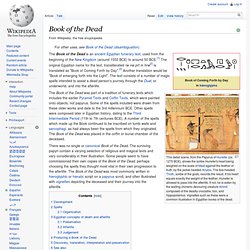
The ibis-headed Thoth, scribe of the gods, records the result. If his heart equals exactly the weight of the feather, Hunefer is allowed to pass into the afterlife. If not, he is eaten by the waiting chimeric devouring creature Ammit composed of the deadly crocodile, lion, and hippopotamus. Vignettes such as these were a common illustration in Egyptian books of the dead. Memento mori. Earthly Vanity and Divine Salvation by Hans Memling.

This triptych contrasts earthly beauty and luxury with the prospect of death and hell. Vanitas. Composition of flowers, less obvious style of Vanitas by Abraham Mignon in the National Museum in Warsaw.
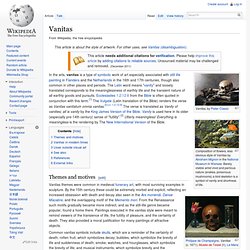
Barely visible amid vivid and perilous nature (snakes, poisonous mushrooms) a bird skeleton is a symbol of vanity and shortness of life. In the arts, vanitas is a type of symbolic work of art especially associated with still life painting in Flanders and the Netherlands in the 16th and 17th centuries, though also common in other places and periods. The Latin word means "vanity" and loosely translated corresponds to the meaninglessness of earthly life and the transient nature of all earthly goods and pursuits.
Ecclesiastes 1:2;12:8 from the Bible is often quoted in conjunction with this term.[1] The Vulgate (Latin translation of the Bible) renders the verse as Vanitas vanitatum omnia vanitas. [Eccl. 1:2;12:8] The verse is translated as Vanity of vanities; all is vanity by the King James Version of the Bible. Themes and motives[edit] Vanitas in modern times[edit] C. Ars moriendi. Pride of the spirit is one of the five temptations of the dying man, according to Ars moriendi.
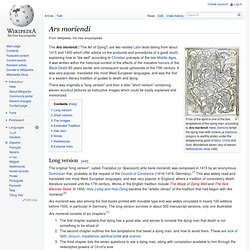
Here, Demons tempt the dying man with crowns (a medieval allegory to earthly pride) under the disapproving gaze of Mary, Christ and God. Woodblock seven (4a) of eleven, Netherlands, circa 1460. The Ars moriendi ("The Art of Dying") are two related Latin texts dating from about 1415 and 1450 which offer advice on the protocols and procedures of a good death, explaining how to "die well" according to Christian precepts of the late Middle Ages. Bardo Thodol. The Bardo Thodol (Tibetan: བར་དོ་ཐོས་གྲོལ, Wylie: bar do thos grol), "Liberation Through Hearing During the Intermediate State", is a text from a larger corpus of teachings, the "Profound Dharma of Self-Liberation through the Intention of the Peaceful and Wrathful Ones",[note 1] revealed by Karma Lingpa (1326–1386).

It is the best-known work of Nyingma literature, being known in the west as the Tibetan Book of the Dead. §Etymology[edit] Bardo thosgroll (Tibetan: བར་དོ་ཐོས་གྲོལ, Wylie: bar do thos grol: bar do, Sankrit antarabhāva - "intermediate state", "transitional state", "in-between state", "liminal state". Valdez: "Used loosely, the term "bardo" refers to the state of existence intermediate between two lives on earth. " §Original text[edit] §Origins and dating[edit] §bar do thos grol[edit] The Tibetan title is bar do thos grol, "Liberation Through Hearing During the Intermediate State". §kar-gling zhi-khro[edit] §Six bardos[edit] §English translations[edit] §Popular influence[edit]
Danse Macabre. Paintings[edit] The earliest recorded visual example is from the cemetery of the Church of the Holy Innocents in Paris (1424–25).
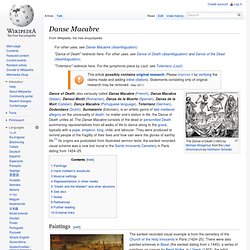
There were also painted schemes in Basel (the earliest dating from c.1440); a series of paintings on canvas by Bernt Notke, in Lübeck (1463); the initial fragment of the original Bernt Notke painting (accomplished at the end of the 15th century) in the St Nicholas' Church, Tallinn, Estonia; the painting at the back wall of the chapel of Sv. Marija na Škrilinama in the Istrian town of Beram (1471), painted by Vincent of Kastav; the painting in the Holy Trinity Church in Hrastovlje in Istria by John of Kastav (1490). There was also a Dance of Death painted in the 1540s on the walls of the cloister of St Paul's Cathedral, London with texts by John Lydgate, which was destroyed in 1549. Voynich. Incunable. Illumination with doodles and drawings, including an open-mouthed human profile, with multiple tongues sticking out.

Copulata, "De Anima", f. 2a. HMD Collection, WZ 230 M772c 1485. Image of two facing pages from "Phisicorum", fols. 57b and 58a, with doodles and drawings. HMD Collection, WZ 230 M772c 1485.